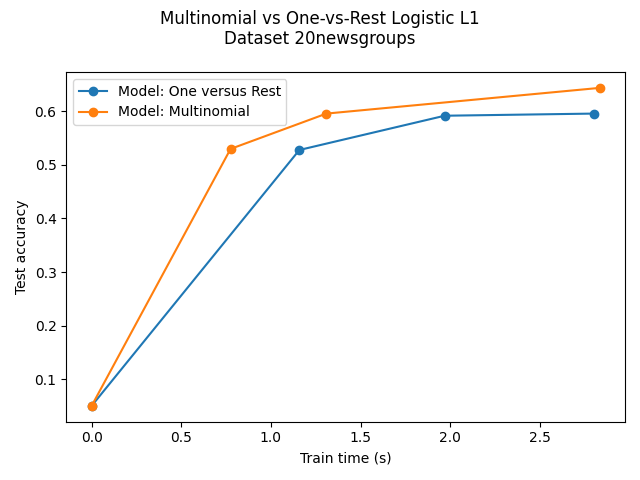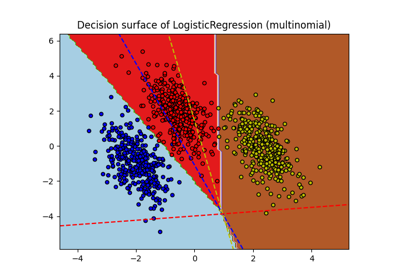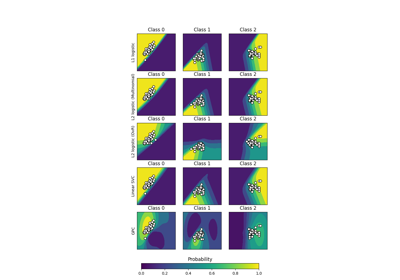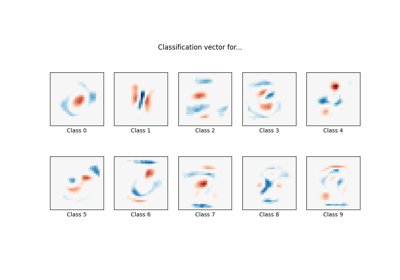Note
Go to the end to download the full example code. or to run this example in your browser via Binder
20类新闻组数据集上的多分类稀疏逻辑回归#
对比多项逻辑回归L1与一对多L1逻辑回归在newgroups20数据集上对文档进行分类的效果。多项逻辑回归在大规模数据集上训练速度更快且结果更准确。
在这里,我们使用L1稀疏性来将不具信息量的特征权重修剪为零。如果目标是提取每个类别的强区分性词汇,这是有益的。如果目标是获得最佳预测准确性,则最好使用不引入稀疏性的L2惩罚。
一种更传统(且可能更好)的在稀疏输入特征子集上进行预测的方法是使用单变量特征选择,然后使用传统的(L2惩罚的)逻辑回归模型。

Dataset 20newsgroup, train_samples=4500, n_features=130107, n_classes=20
[model=One versus Rest, solver=saga] Number of epochs: 1
[model=One versus Rest, solver=saga] Number of epochs: 2
[model=One versus Rest, solver=saga] Number of epochs: 3
Test accuracy for model ovr: 0.5960
% non-zero coefficients for model ovr, per class:
[0.26593496 0.43348936 0.26362917 0.31973683 0.37815029 0.2928359
0.27054655 0.62717609 0.19522393 0.30897646 0.34586917 0.28207552
0.34125758 0.29898468 0.34279478 0.59489497 0.38353048 0.35278655
0.19829832 0.14603365]
Run time (3 epochs) for model ovr:2.80
[model=Multinomial, solver=saga] Number of epochs: 1
[model=Multinomial, solver=saga] Number of epochs: 2
[model=Multinomial, solver=saga] Number of epochs: 5
Test accuracy for model multinomial: 0.6440
% non-zero coefficients for model multinomial, per class:
[0.36047253 0.1268187 0.10606655 0.17985197 0.5395559 0.07993421
0.06686804 0.21443888 0.11528972 0.2075215 0.10914094 0.11144673
0.13988486 0.09684337 0.26286057 0.11682692 0.55800226 0.17370318
0.11452112 0.14603365]
Run time (5 epochs) for model multinomial:2.83
Example run in 11.676 s
# Author: Arthur Mensch
import timeit
import warnings
import matplotlib.pyplot as plt
import numpy as np
from sklearn.datasets import fetch_20newsgroups_vectorized
from sklearn.exceptions import ConvergenceWarning
from sklearn.linear_model import LogisticRegression
from sklearn.model_selection import train_test_split
from sklearn.multiclass import OneVsRestClassifier
warnings.filterwarnings("ignore", category=ConvergenceWarning, module="sklearn")
t0 = timeit.default_timer()
# 我们使用SAGA求解器
solver = "saga"
# 降低以加快运行时间
n_samples = 5000
X, y = fetch_20newsgroups_vectorized(subset="all", return_X_y=True)
X = X[:n_samples]
y = y[:n_samples]
X_train, X_test, y_train, y_test = train_test_split(
X, y, random_state=42, stratify=y, test_size=0.1
)
train_samples, n_features = X_train.shape
n_classes = np.unique(y).shape[0]
print(
"Dataset 20newsgroup, train_samples=%i, n_features=%i, n_classes=%i"
% (train_samples, n_features, n_classes)
)
models = {
"ovr": {"name": "One versus Rest", "iters": [1, 2, 3]},
"multinomial": {"name": "Multinomial", "iters": [1, 2, 5]},
}
for model in models:
# 添加初始机会水平值以用于绘图目的
accuracies = [1 / n_classes]
times = [0]
densities = [1]
model_params = models[model]
# 少量的训练周期以加快运行时间
for this_max_iter in model_params["iters"]:
print(
"[model=%s, solver=%s] Number of epochs: %s"
% (model_params["name"], solver, this_max_iter)
)
clf = LogisticRegression(
solver=solver,
penalty="l1",
max_iter=this_max_iter,
random_state=42,
)
if model == "ovr":
clf = OneVsRestClassifier(clf)
t1 = timeit.default_timer()
clf.fit(X_train, y_train)
train_time = timeit.default_timer() - t1
y_pred = clf.predict(X_test)
accuracy = np.sum(y_pred == y_test) / y_test.shape[0]
if model == "ovr":
coef = np.concatenate([est.coef_ for est in clf.estimators_])
else:
coef = clf.coef_
density = np.mean(coef != 0, axis=1) * 100
accuracies.append(accuracy)
densities.append(density)
times.append(train_time)
models[model]["times"] = times
models[model]["densities"] = densities
models[model]["accuracies"] = accuracies
print("Test accuracy for model %s: %.4f" % (model, accuracies[-1]))
print(
"%% non-zero coefficients for model %s, per class:\n %s"
% (model, densities[-1])
)
print(
"Run time (%i epochs) for model %s:%.2f"
% (model_params["iters"][-1], model, times[-1])
)
fig = plt.figure()
ax = fig.add_subplot(111)
for model in models:
name = models[model]["name"]
times = models[model]["times"]
accuracies = models[model]["accuracies"]
ax.plot(times, accuracies, marker="o", label="Model: %s" % name)
ax.set_xlabel("Train time (s)")
ax.set_ylabel("Test accuracy")
ax.legend()
fig.suptitle("Multinomial vs One-vs-Rest Logistic L1\nDataset %s" % "20newsgroups")
fig.tight_layout()
fig.subplots_adjust(top=0.85)
run_time = timeit.default_timer() - t0
print("Example run in %.3f s" % run_time)
plt.show()
Total running time of the script: (0 minutes 11.717 seconds)
Related examples





